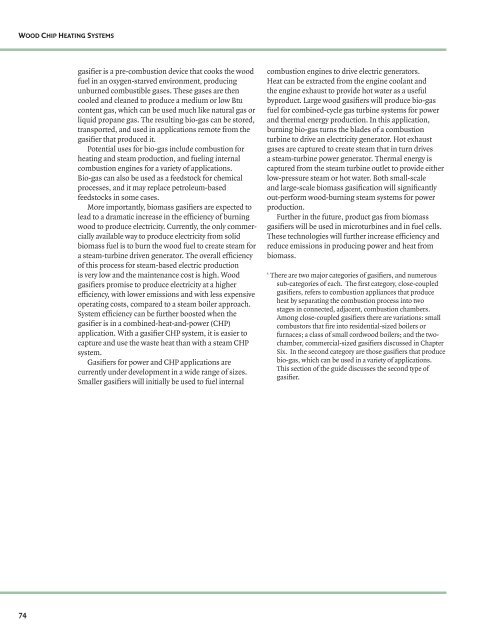Wood-Chip Heating Systems - Biomass Energy Resource Center
Wood-Chip Heating Systems - Biomass Energy Resource Center
Wood-Chip Heating Systems - Biomass Energy Resource Center
You also want an ePaper? Increase the reach of your titles
YUMPU automatically turns print PDFs into web optimized ePapers that Google loves.
WOOD CHIP HEATING SYSTEMS<br />
74<br />
gasifi er is a pre-combustion device that cooks the wood<br />
fuel in an oxygen-starved environment, producing<br />
unburned combustible gases. These gases are then<br />
cooled and cleaned to produce a medium or low Btu<br />
content gas, which can be used much like natural gas or<br />
liquid propane gas. The resulting bio-gas can be stored,<br />
transported, and used in applications remote from the<br />
gasifi er that produced it.<br />
Potential uses for bio-gas include combustion for<br />
heating and steam production, and fueling internal<br />
combustion engines for a variety of applications.<br />
Bio-gas can also be used as a feedstock for chemical<br />
processes, and it may replace petroleum-based<br />
feedstocks in some cases.<br />
More importantly, biomass gasifi ers are expected to<br />
lead to a dramatic increase in the effi ciency of burning<br />
wood to produce electricity. Currently, the only commercially<br />
available way to produce electricity from solid<br />
biomass fuel is to burn the wood fuel to create steam for<br />
a steam-turbine driven generator. The overall effi ciency<br />
of this process for steam-based electric production<br />
is very low and the maintenance cost is high. <strong>Wood</strong><br />
gasifi ers promise to produce electricity at a higher<br />
effi ciency, with lower emissions and with less expensive<br />
operating costs, compared to a steam boiler approach.<br />
System effi ciency can be further boosted when the<br />
gasifi er is in a combined-heat-and-power (CHP)<br />
application. With a gasifi er CHP system, it is easier to<br />
capture and use the waste heat than with a steam CHP<br />
system.<br />
Gasifi ers for power and CHP applications are<br />
currently under development in a wide range of sizes.<br />
Smaller gasifi ers will initially be used to fuel internal<br />
combustion engines to drive electric generators.<br />
Heat can be extracted from the engine coolant and<br />
the engine exhaust to provide hot water as a useful<br />
byproduct. Large wood gasifi ers will produce bio-gas<br />
fuel for combined-cycle gas turbine systems for power<br />
and thermal energy production. In this application,<br />
burning bio-gas turns the blades of a combustion<br />
turbine to drive an electricity generator. Hot exhaust<br />
gases are captured to create steam that in turn drives<br />
a steam-turbine power generator. Thermal energy is<br />
captured from the steam turbine outlet to provide either<br />
low-pressure steam or hot water. Both small-scale<br />
and large-scale biomass gasifi cation will signifi cantly<br />
out-perform wood-burning steam systems for power<br />
production.<br />
Further in the future, product gas from biomass<br />
gasifi ers will be used in microturbines and in fuel cells.<br />
These technologies will further increase effi ciency and<br />
reduce emissions in producing power and heat from<br />
biomass.<br />
1 There are two major categories of gasifi ers, and numerous<br />
sub-categories of each. The fi rst category, close-coupled<br />
gasifi ers, refers to combustion appliances that produce<br />
heat by separating the com bus tion process into two<br />
stages in connected, adjacent, combustion chambers.<br />
Among close-coupled gasifi ers there are variations: small<br />
combustors that fi re into residential-sized boilers or<br />
furnaces; a class of small cordwood boilers; and the twochamber,<br />
commercial-sized gasifi ers discussed in Chapter<br />
Six. In the second category are those gasifi ers that produce<br />
bio-gas, which can be used in a variety of ap pli ca tions.<br />
This section of the guide discusses the second type of<br />
gasifi er.





